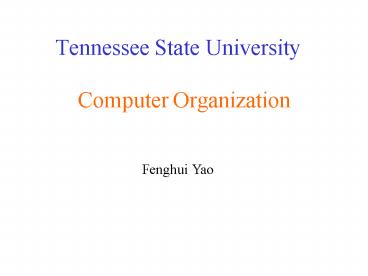Computer Organization - PowerPoint PPT Presentation
1 / 25
Title:
Computer Organization
Description:
IBM7090: transistorized successor to IBM709 (vacuum tube machine) cost millions ... 1.3 The Computer Zoo. Technological and Economic Forces. The Computer Spectrum ... – PowerPoint PPT presentation
Number of Views:236
Avg rating:3.0/5.0
Title: Computer Organization
1
Computer Organization
- Tennessee State University
Fenghui Yao
2
Overview
- Introduction to the course
- - goals
- - organization
- - outline
- Introduction to the Computer Organization
- Conclusions
3
Goals
- Understanding the computer organization
- Study example CPUs Pentium II, UltraSPARC II,
picoJava II. - The design and implementation issues of computers
will be clarified. - The course prepares for the design and
implementation of new computers.
4
Organization
- Schedule
- Text book
- Andrew S. Tanenbaum Structured Computer
Organization, 4th ed., Prentice Hall, 1999.
5
Outline
- Introduction
- Computer systems organization
- The digital logic level
- The microarchitecture level
- The instruction set architechture level
- The operating system machine level
- The assembly language level
- Parallel computer architectures
6
1. Introduction
- 1.1 Structured computer organization
- 1.2 Milestones in computer architecture
- 1.3 The computer zoo
- 1.4 Example computer families
- 1.5 Outline of this book
7
- Primitive operations in a program
- Add 2 numbers.
- Check a number to see if it is zero
- Copy a piece of data from one part of the
computer memory to another. - Machine language a set of CPUs primitive
instructions - Computer design
- decide what instructions to include in its
machine language - make instructions as simple as possible
- e.g. 01100000 (IADD in IJVM )
- Structured computer architecture a series of
abstractions, each abstraction building on the
one below it.
8
1.1 Structure computer organization
Languages, Levels, and Virtual Machines
9
Contemporary Multilevel Machines
10
1.2 Milestones in computer architechture
The zeroth generation
The first generation
The second generation
The third generation
The fourth generation
11
The First Generation Vacuum Tubes (1945-1955)
- ENIAC(Electronic Numerical Integrator And
Computer, 1946) J. Mauchley, J. P. Eckert - 18,000 vacuum tubes, 1500 relays,
- weight 30 tons, power 140kw
- Programming
- 6000 multiposition switches and jumper cables
- decimal arithmetic
- ABC (Atanasoff - Berry Computer, Iowa Univ., 1942
)
12
- Neuman Machine
- the program stored in the computers memory
- Binary arithmetic
- The idea was used in EDSAC made by Wilkes.
13
The Second Generation Transistors (1955-1965)
- MITs Lincoln Laboratory TX-0, TX-2
- TX-0 the first transitorized computer
- IBM IBM7090
- IBM7090 transistorized successor to IBM709
(vacuum tube machine) cost millions - DEC (formed by Kenneth Olsen) PDP-1, PDP-8
- PDP-1 1961, cost 120,000, sold dozens.
- minicomputer industry was born
14
PDP-8 much cheaper than PDP-1, cost 16,000
major innovation single bus This architecture
has been adopted by nearly all small computers
since then
15
The Third Generation IC (1965-1980)
- IC Integrated Circuit
- - dozens of transistors to be put on a single
chip. - - possible to build computers that were
smaller, faster, and cheaper - Machine families based on ICs
- - using the same assembly language
- - software written for one of them could run
on the other.
16
IBM 360 machine family
Increasing size and power
OS multiprogramming Minicomputer world PDP-11
series
17
The Fourth Generation VLSI (1980-present)
- VLSI Very Large Scale IC
- - tens of thousands, then hundreds of
thousands, and finally millions of transistors to
be put on a single chip. - - possible to build computer that were smaller,
faster, and cheaper. - Personal computer era
- - IBM PC, Apple PC
- OS MS-DOS, Windows, Mac OS, UNIX, Linux etc.
18
1.3 The Computer Zoo Technological and
Economic Forces
19
The Computer Spectrum
20
Example Computer FamiliesIntroduction to the
Pentium II
2003, Pentium ?, 3.2GHz
21
(No Transcript)
22
Introduction to the UltraSPARC II
- Sun Microsystems founded in 1982
- Sun-1, Sun-2, Sun-3
- - Motorola CPUs
- - Equipped with Ethernet connection and with
TCP/IP software - In 1987, Sun designed its own RISC CPU SPARC
(Scalable Processor ARChitecture), formed the
basis of Sun-4 workstation. - - 32-bit, 36MHz (contrast to Intel line 8-
and 16-bit 8088, 8086, 80286, 32-bit 80386) - In 1995, UltraSPARC I (Ver 9 SPARC architecture )
- - 64-bit machine, but compatible with 32-bit
SPARCs. - - 2 TB (1012 bytes) memory space.
- UltraSPARC II, III successors of UltraSPARC I,
differ primarily in clock speed.
23
Introduction to the picoJava II
- Java
- - to fetch binary programs over Internet and
run them as part of WWW page. - - a type-safe object-oriented language.
- - possible to write compilers that compile to
Pentium, SPARC, or other architecture. - JVM (Java Virtual Machine) to make binary
programs portable across different machines. - - memory consisting of 32-bit words, 226
instructions - - Java compiler compiles Java to JVM.
- - JVM interpreter to execute Java binary
program. - Problem Interpreting JVM programs is slow.
24
- Hardware JVM chips picoJava-I (1997),
picoJava-II (1998) - directly execute JVM binary programs,
without the need for a layer of software
interpretation. - picoJava II not a concrete chip, but the basis
for a number of chips, such as Sun microJava 701
CPU. - picoJava II has two optional units a cache and
a floating-point unit which each chip
manufacturer can include or remove, as it wishes.
- Our example CPUs Pentium II, UltraSPARC II,
picoJava II
25
Conclusions
- Introducing structured computer organization
- Review of Computer History
- Example CPUs Pentium II, UltraSPARC II,
- picoJava II
- What next ?
- Computer System Organization































